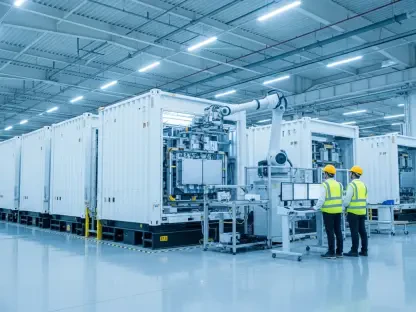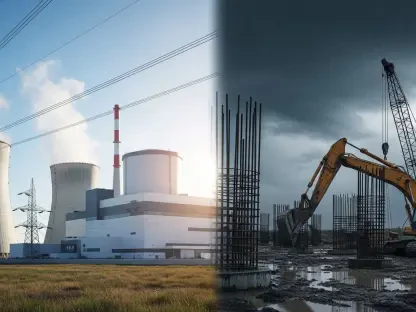The rising urgency of climate change and the global shift towards sustainability have opened up a plethora of investment opportunities in green technologies. Investors are increasingly looking to capitalize on high-growth sectors that promise substantial returns while contributing to environmental preservation. This article explores seven green technologies that stand out as the most promising investment opportunities in today’s market.
Next-Generation Solar Power
Innovations in Solar Technology
Recent advancements in solar technology, such as perovskite solar cells, solar skins, and floating solar farms, are revolutionizing the industry. These innovations are making solar power more efficient and cost-effective, attracting significant investor interest. Perovskite solar cells, for instance, have demonstrated potential for high efficiency at a fraction of the cost of traditional silicon-based cells. Moreover, the development of solar skins, which can be seamlessly integrated into building materials, has the potential to transform how we design and power our homes and offices. The emergence of floating solar farms further extends the possibilities, allowing solar panels to be installed on bodies of water, thus maximizing land use and improving energy yields.
In addition to these innovations, there is a growing focus on improving the overall lifespan and durability of solar panels. Researchers are working on anti-reflective coatings and self-cleaning materials to enhance performance and reduce maintenance costs. As the cost of solar technology continues to decrease, the return on investment for solar projects is becoming increasingly attractive. This trend is drawing the attention of both private investors and large financial institutions, which are keen to capitalize on the expanding solar market. These advancements are not only promising substantial returns but are also playing a crucial role in the global transition to renewable energy sources.
Government Incentives and Accessibility
With the global push for net-zero emissions, governments are offering various incentives for solar power adoption. Homeowners now have access to multiple financing options and tax benefits, making solar installations more financially attractive. In the United States, for example, the federal Investment Tax Credit (ITC) allows homeowners and businesses to deduct a significant percentage of their solar installation costs from their federal taxes. Additionally, various states offer their own incentives, such as rebates, grants, and performance-based incentives, further reducing the upfront cost of solar projects.
The combination of these incentives has led to a dramatic increase in the adoption of residential and commercial solar installations. Moreover, innovative financing models, such as power purchase agreements (PPAs) and solar leasing, have made it possible for homeowners to install solar panels with little to no upfront cost. These models allow homeowners to pay for the solar energy generated by their panels through fixed monthly payments or as a percentage of the energy savings. This accessibility has significantly broadened the market, enabling more people to participate in the transition to clean energy.
Governments around the world are also implementing policies to encourage the development of large-scale solar projects. Through competitive auctions and feed-in tariffs, they are ensuring stable and predictable revenue streams for solar developers. This policy support is creating a favorable environment for solar investments, attracting both domestic and international investors. As countries continue to raise their renewable energy targets and introduce more aggressive climate policies, the demand for solar power is expected to grow exponentially, offering lucrative investment opportunities in the years to come.
Solid-State Batteries for Electric Vehicles (EVs)
Future of EV Market
Solid-state batteries represent a major breakthrough in the EV market. These batteries offer faster charging, increased longevity, and enhanced safety, positioning them as the future standard for electric vehicles. Unlike traditional lithium-ion batteries, solid-state batteries use a solid electrolyte instead of a liquid one, which significantly reduces the risk of overheating and potential fires. This fundamental change not only improves the safety profile of electric vehicles but also allows for higher energy densities, which can lead to longer driving ranges and reduced charging times. These advancements are critical in addressing some of the main barriers to widespread EV adoption, such as range anxiety and long charging times.
The automotive industry is rapidly moving towards electrification, driven by stringent emissions regulations and changing consumer preferences. Major automakers like Toyota, BMW, and Volkswagen are heavily investing in the development and commercialization of solid-state batteries. As the technology matures and production scales up, the cost of solid-state batteries is expected to decrease, making electric vehicles more affordable and competitive with traditional internal combustion engine vehicles. This shift is creating a substantial opportunity for investors to get in early on a technology that is poised to dominate the EV market in the coming years.
Broader Applications and Investment Potential
Beyond EVs, solid-state batteries have potential applications in consumer electronics and renewable energy storage. Early investors in this technology could see substantial returns as it gains commercial dominance. In the consumer electronics space, the demand for more efficient, longer-lasting batteries is ever-growing. Solid-state batteries can provide the energy density and safety required for high-demand devices such as smartphones, laptops, and wearable technology. The ability to hold more charge in a smaller and more stable package makes solid-state batteries an attractive option for next-generation electronic devices.
In the realm of renewable energy, solid-state batteries offer promising solutions for energy storage systems. As the integration of renewable energy sources like solar and wind power increases, the need for efficient, reliable energy storage becomes more critical. Solid-state batteries can store excess energy generated during peak production times and release it when demand is high or production is low, thereby ensuring a stable energy supply. This capability is essential for the continued expansion of renewable energy infrastructure and the transition to a more sustainable energy grid.
Investing in solid-state battery technology provides a unique opportunity to be at the forefront of multiple high-growth markets. As the technology evolves and becomes more widely adopted, companies involved in its development and manufacturing are likely to experience significant revenue growth. Investors who recognize the potential of solid-state batteries early on and allocate capital accordingly could reap substantial rewards as the market for this transformative technology continues to expand.
Carbon Capture & Utilization
Addressing Carbon Regulations
Technologies that capture and convert CO₂ into useful materials are becoming increasingly important. These innovations are essential for meeting stringent carbon regulations and have diverse applications, from creating fuel to synthetic diamonds. The urgency to reduce greenhouse gas emissions has never been higher, and carbon capture and utilization (CCU) technologies are emerging as pivotal solutions. By capturing CO₂ emissions at the source, such as from power plants and industrial facilities, and converting it into valuable products, these technologies can significantly reduce the overall carbon footprint.
One promising application of CCU is the production of synthetic fuels. By combining captured CO₂ with hydrogen produced from renewable energy sources, it is possible to create carbon-neutral fuels that can be used in existing internal combustion engines and aviation. This approach provides a viable pathway to decarbonize sectors that are challenging to electrify, such as heavy transportation and aviation. Additionally, CCU can be used to produce construction materials like concrete, where CO₂ is mineralized and incorporated into the material, effectively sequestering the carbon for the long term.
Government Support and Market Demand
Government incentives and the urgent need for scalable carbon removal solutions are driving investment in carbon capture technologies. This sector is poised for significant growth as industries seek sustainable practices. Many countries have introduced policies and financial incentives to support the development and deployment of CCU technologies. For instance, the United States offers tax credits under the 45Q tax provision for carbon capture projects, providing financial benefits based on the amount of CO₂ captured and utilized. Additionally, the European Union has earmarked substantial funding for carbon capture research and pilot projects as part of its climate action initiatives.
The market demand for CCU technologies is also on the rise, driven by corporate sustainability commitments and the increasing cost of carbon emissions. Companies across various industries are setting ambitious targets to achieve net-zero emissions, and CCU provides a practical solution to offset their residual emissions. This increasing demand is encouraging innovation and investment in the sector, leading to the development of new and more efficient carbon capture methods.
Investors who recognize the potential of CCU technologies can capitalize on the growing momentum and support from governments and industry players. As the urgency to address climate change intensifies, the adoption of carbon capture and utilization is expected to accelerate, presenting lucrative opportunities for those who invest in the early stages of this burgeoning market.
Water Purification & Desalination
Various technologies encompass water purification and desalination processes, aimed at making water safe and potable. By removing contaminants such as bacteria, viruses, and harmful chemicals, these systems ensure access to clean drinking water. Desalination specifically focuses on converting seawater into freshwater, primarily through reverse osmosis or distillation. As freshwater resources become scarcer, the importance of efficient and cost-effective water purification and desalination methods grows, addressing critical water supply challenges worldwide.
Technological Advancements
Innovations like graphene-based filtration, solar desalination, and atmospheric water generators are addressing the global water scarcity issue. These technologies are attracting considerable investment due to their potential to provide clean water solutions. Graphene-based filtration systems, for example, offer superior performance compared to traditional filters by utilizing the unique properties of graphene to remove contaminants more effectively and efficiently. This cutting-edge technology is being adopted in various applications, from municipal water treatment plants to portable water purification devices, making it a versatile solution for different water needs.
Solar desalination is another promising technology that harnesses the power of the sun to convert seawater into freshwater. By using renewable energy, solar desalination systems can operate sustainably and cost-effectively, making them ideal for regions with abundant solar resources but limited freshwater availability. Advances in this field are focused on improving the efficiency of solar stills and integrating them with other renewable energy systems to optimize performance.
Atmospheric water generators are also gaining traction as a viable solution to water scarcity. These devices extract moisture from the air and condense it into potable water, providing a decentralized and scalable option for water generation. Innovations in this technology are aimed at enhancing energy efficiency and reducing operational costs, making atmospheric water generators more accessible and practical for widespread use.
Market Necessity
As freshwater resources become scarcer, the demand for advanced water purification and desalination technologies is increasing. Investors are recognizing the critical importance of these innovations in ensuring a sustainable water supply. The United Nations projects that by 2025, two-thirds of the world’s population could face water shortages, highlighting the urgent need for effective water management solutions. This growing scarcity is driving governments and organizations to invest heavily in water infrastructure and technological advancements to address the crisis.
In developing countries, access to clean water remains a significant challenge, with millions of people lacking reliable sources of safe drinking water. Innovations in water purification and desalination technologies can play a crucial role in providing these communities with the resources they need to thrive. By investing in companies that are developing and deploying these solutions, investors can make a meaningful impact while also achieving attractive returns.
The increasing demand for clean water is also being driven by industrial and agricultural sectors, which require large volumes of water for their operations. As regulatory pressures to reduce water consumption and improve water efficiency grow, businesses are seeking advanced technologies to meet these requirements. This trend is creating a robust market for water purification and desalination solutions, presenting significant opportunities for investors who are looking to support sustainable growth in this essential sector.
AI-Powered Smart Grids
Optimizing Energy Distribution
Smart grids that leverage artificial intelligence are transforming energy distribution. These grids optimize energy use, enhance reliability, and reduce waste, making them a vital area for investment. By incorporating AI algorithms and machine learning techniques, smart grids can analyze vast amounts of data in real-time to make informed decisions about energy distribution. This capability allows them to respond quickly to changes in demand, predict potential issues before they occur, and optimize the integration of renewable energy sources into the grid.
One of the key advantages of AI-powered smart grids is their ability to balance supply and demand more effectively. By accurately forecasting energy consumption patterns and adjusting power generation accordingly, these grids can minimize energy wastage and reduce the need for costly and polluting peaker plants. Additionally, smart grids can enhance grid stability by identifying and addressing potential faults and outages before they escalate, thereby improving overall reliability and reducing downtime.
The integration of AI in energy distribution also opens up new possibilities for demand response programs, where consumers are incentivized to adjust their energy usage during peak periods. By leveraging real-time data and machine learning, smart grids can provide dynamic pricing signals and automate load management, making demand response more efficient and effective. These advancements are not only improving the performance of our energy systems but also creating new business models and revenue streams for energy providers.
Integration with Renewable Energy
AI-driven smart grids are crucial for integrating renewable energy sources into the power supply. Their ability to prevent blackouts and improve grid efficiency underscores their importance in the modernization of global energy infrastructure. The intermittent nature of renewable energy sources like solar and wind presents significant challenges for grid operators, who must ensure a stable and reliable energy supply despite fluctuations in generation.
AI-powered smart grids address these challenges by using predictive analytics to forecast renewable energy production and optimize its integration into the grid. By accurately predicting when and how much energy will be generated from renewable sources, smart grids can make better decisions about when to store excess energy in batteries or other storage systems and when to dispatch it to meet demand. This capability is essential for maximizing the use of renewable energy and reducing reliance on fossil fuel-based power generation.
Furthermore, smart grids can enhance the efficiency and reliability of decentralized energy systems, where energy is generated and consumed locally. By coordinating the operation of distributed energy resources like rooftop solar panels, electric vehicles, and home energy storage systems, AI-driven smart grids can create more resilient and self-sufficient energy networks. This decentralized approach not only improves energy security but also reduces transmission losses and mitigates the impact of central grid failures.
As the global energy landscape continues to evolve, the role of AI-powered smart grids in integrating renewable energy and optimizing energy distribution will become increasingly important. Investors who recognize the potential of this technology early on can capitalize on the growing demand for advanced grid solutions and contribute to the sustainable transformation of our energy systems.
Green Hydrogen Fuel
Renewable Energy Production
Green hydrogen, produced using renewable energy, is emerging as a viable alternative to fossil fuels. Significant investments from governments and corporations are advancing this technology’s production, storage, and distribution. Green hydrogen is produced through the process of electrolysis, where water is split into hydrogen and oxygen using electricity generated from renewable sources like solar, wind, or hydropower. This method results in a zero-emission fuel that can be used in various applications, from transportation to industrial processes.
One of the key drivers of green hydrogen’s growth is its potential to decarbonize hard-to-electrify sectors. Heavy industries such as steelmaking, cement production, and chemical manufacturing require high-temperature heat and hydrogen as a feedstock, which are challenging to achieve with electricity alone. Green hydrogen offers a clean alternative that can meet these demands while significantly reducing carbon emissions. Additionally, green hydrogen can be used as a fuel for heavy-duty transportation, such as trucks, ships, and trains, where battery-electric solutions may not be practical due to weight and range limitations.
Market Growth and Investment Opportunities
With breakthroughs in electrolyzer efficiency and cost reduction, green hydrogen is forecasted to become a trillion-dollar market. This sector offers unique investment opportunities as it reshapes global energy markets. Governments around the world are recognizing the potential of green hydrogen and are implementing policies and funding programs to support its development. For example, the European Union has set ambitious targets for green hydrogen production as part of its Green Deal, and countries like Japan and South Korea have established national hydrogen strategies to promote the technology’s adoption.
Private sector investments are also accelerating the growth of green hydrogen. Major energy companies, including Shell, BP, and Total, are investing in large-scale green hydrogen projects and forming strategic partnerships to advance the technology. These initiatives are aimed at developing integrated hydrogen supply chains, from production and storage to distribution and end-use applications. As the cost of electrolyzers continues to decline and economies of scale are realized, green hydrogen is expected to become increasingly competitive with fossil fuels, driving further investment and market expansion.
The potential market for green hydrogen extends beyond traditional energy sectors. It includes new and emerging applications such as hydrogen-powered aviation, fuel cell vehicles, and residential heating systems. Investors who recognize the transformative potential of green hydrogen early on can capitalize on this diverse and rapidly growing market. By supporting companies that are pioneering green hydrogen solutions, investors can contribute to the development of a sustainable energy ecosystem and benefit from the substantial returns that this market has to offer.
Biodegradable & Smart Packaging
Innovations in Sustainable Packaging
The development of compostable plastics, edible packaging, and smart materials is addressing the environmental impact of traditional packaging. These innovations are gaining traction as businesses seek eco-friendly alternatives. Compostable plastics, made from renewable resources like corn starch, break down into natural components under composting conditions, reducing the amount of plastic waste that ends up in landfills and oceans. Edible packaging, crafted from materials such as seaweed and rice paper, provides a zero-waste solution for food packaging, further minimizing environmental impact.
Smart packaging technologies are also revolutionizing the industry by incorporating advanced functionalities like freshness indicators, tamper-evidence, and improved product tracking. These features not only enhance the consumer experience but also contribute to waste reduction by extending product shelf life and reducing spoilage. Innovations in sustainable packaging are being driven by both consumer demand and regulatory pressures, as governments worldwide implement stricter guidelines to reduce plastic waste and promote circular economies.
Consumer and Market Demand
As the urgency of addressing climate change intensifies and the global push towards sustainability strengthens, a wide array of investment opportunities in green technologies has emerged. Investors are increasingly eager to tap into high-growth sectors that not only offer substantial financial returns but also contribute to protecting the environment. This article delves into seven green technologies that are currently seen as the most promising investment prospects in today’s market. From renewable energy sources like solar and wind power to innovations in energy storage and electric vehicles, these technologies represent significant progress toward a more sustainable future. Moreover, advancements in green building materials, water purification solutions, and sustainable agriculture are creating new avenues for investment. Each of these sectors presents unique opportunities for achieving returns while fostering environmental stewardship. This exploration is intended to encourage informed decision-making for those looking to invest in eco-friendly technologies and support the global movement towards a greener world.









